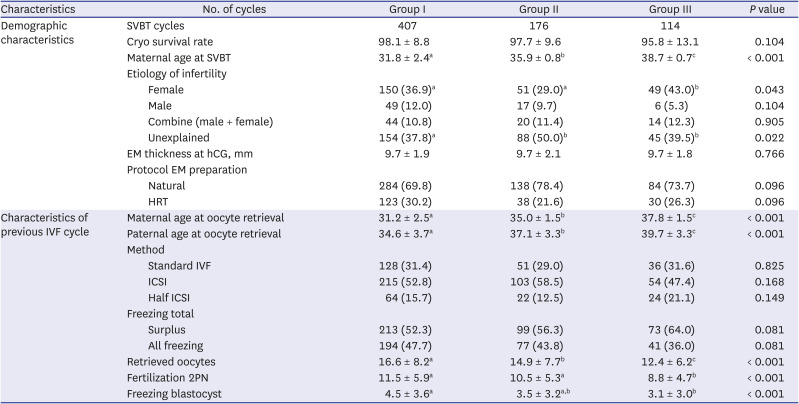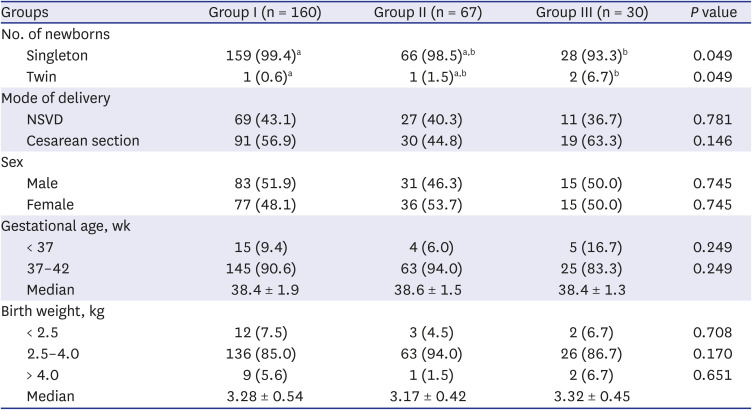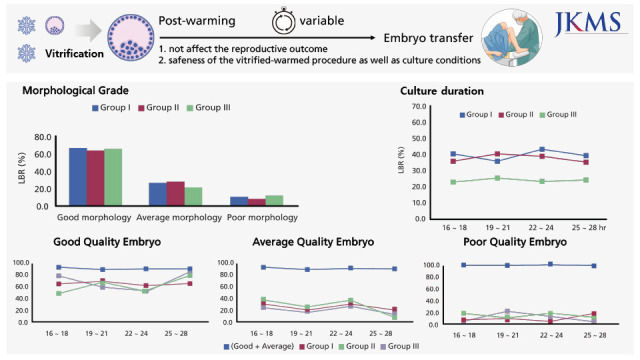1. Rienzi L, Gracia C, Maggiulli R, LaBarbera AR, Kaser DJ, Ubaldi FM, et al. Oocyte, embryo and blastocyst cryopreservation in ART: systematic review and meta-analysis comparing slow-freezing versus vitrification to produce evidence for the development of global guidance. Hum Reprod Update. 2017; 23(2):139–155. PMID:
27827818.
2. Roque M, Lattes K, Serra S, Solà I, Geber S, Carreras R, et al. Fresh embryo transfer versus frozen embryo transfer in in vitro fertilization cycles: a systematic review and meta-analysis. Fertil Steril. 2013; 99(1):156–162. PMID:
23040524.
3. Hammond ER, Foong AK, Rosli N, Morbeck DE. Should we freeze it? Agreement on fate of borderline blastocysts is poor and does not improve with a modified blastocyst grading system. Hum Reprod. 2020; 35(5):1045–1053. PMID:
32358601.
4. Devine K, Connell MT, Richter KS, Ramirez CI, Levens ED, DeCherney AH, et al. Single vitrified blastocyst transfer maximizes liveborn children per embryo while minimizing preterm birth. Fertil Steril. 2015; 103(6):1454–1460.e1. PMID:
25813283.
5. Shapiro BS, Daneshmand ST, Garner FC, Aguirre M, Hudson C. Freeze-all can be a superior therapy to another fresh cycle in patients with prior fresh blastocyst implantation failure. Reprod Biomed Online. 2014; 29(3):286–290. PMID:
24912413.
6. Doody KJ. Cryopreservation and delayed embryo transfer-assisted reproductive technology registry and reporting implications. Fertil Steril. 2014; 102(1):27–31. PMID:
24907917.
7. Veleva Z, Orava M, Nuojua-Huttunen S, Tapanainen JS, Martikainen H. Factors affecting the outcome of frozen-thawed embryo transfer. Hum Reprod. 2013; 28(9):2425–2431. PMID:
23756705.
8. Desai N, Ploskonka S, Goodman L, Attaran M, Goldberg JM, Austin C, et al. Delayed blastulation, multinucleation, and expansion grade are independently associated with live-birth rates in frozen blastocyst transfer cycles. Fertil Steril. 2016; 106(6):1370–1378. PMID:
27565255.
9. Deng J, Zhao Q, Cinnioglu C, Kayali R, Lathi RB, Behr B. The impact of culture conditions on blastocyst formation and aneuploidy rates: a comparison between single-step and sequential media in a large academic practice. J Assist Reprod Genet. 2020; 37(1):161–169. PMID:
31950455.
10. Chua SJ, Danhof NA, Mochtar MH, van Wely M, McLernon DJ, Custers I, et al. Age-related natural fertility outcomes in women over 35 years: a systematic review and individual participant data meta-analysis. Hum Reprod. 2020; 35(8):1808–1820. PMID:
32696041.
11. Kenny LC, Lavender T, McNamee R, O’Neill SM, Mills T, Khashan AS. Advanced maternal age and adverse pregnancy outcome: evidence from a large contemporary cohort. PLoS One. 2013; 8(2):e56583. PMID:
23437176.
12. Kim HJ, Park JK, Eum JH, Song H, Lee WS, Lyu SW. Embryo selection based on morphological parameters in a single vitrified-warmed blastocyst transfer cycle. Reprod Sci. 2021; 28(4):1060–1068. PMID:
33051819.
13. Kim MK, Park JK, Jeon Y, Choe SA, Lee HJ, Kim J, et al. Correlation between morphologic grading and euploidy rates of blastocysts, and clinical outcomes in in vitro fertilization preimplantation genetic screening. J Korean Med Sci. 2019; 34(4):e27. PMID:
30686949.
14. Matsuura K, Hayashi N, Takiue C, Hirata R, Habara T, Naruse K. Blastocyst quality scoring based on morphologic grading correlates with cell number. Fertil Steril. 2010; 94(3):1135–1137. PMID:
20079898.
15. Lee HN, Park JK, Paek SK, Byun JH, Song H, Lee HJ, et al. Does duration of cryostorage affect survival rate, pregnancy, and neonatal outcomes? Large-scale single-center study of slush nitrogen (SN
2) vitrified-warmed blastocysts. Int J Gynaecol Obstet. 2021; 152(3):351–357. PMID:
32961588.
16. Castillo CM, Harper J, Roberts SA, O’Neill HC, Johnstone ED, Brison DR. The impact of selected embryo culture conditions on ART treatment cycle outcomes: a UK national study. Hum Reprod Open. 2020; 2020(1):hoz031. PMID:
32083189.
17. Colodetti L, Pinho de França P, Sampaio M, Geber S. Do different culture intervals (2 × 24 hours) after thaw of cleavage stage embryos affect pregnancy rates? A randomized controlled trial. Cryobiology. 2020; 95:80–83. PMID:
32533985.
18. Rato ML, Gouveia-Oliveira A, Plancha CE. Influence of post-thaw culture on the developmental potential of human frozen embryos. J Assist Reprod Genet. 2012; 29(8):789–795. PMID:
22614160.
19. Zhu H, Xu W, Jin X, Xue Y, Tong X, Zhang S. Association of the duration of post-thaw culture with clinical outcome after vitrified-warmed day 3 embryo transfer in 10,464 cycles: a retrospective cohort study. Medicine (Baltimore). 2020; 99(33):e21660. PMID:
32872029.
20. Alikani M. Looking for signs of life after thaw. Fertil Steril. 2018; 110(7):1259–1260. PMID:
30503117.
21. Dew JE, Don RA, Hughes GJ, Johnson TC, Steigrad SJ. The influence of advanced age on the outcome of assisted reproduction. J Assist Reprod Genet. 1998; 15(4):210–214. PMID:
9565851.
22. Klipstein S, Regan M, Ryley DA, Goldman MB, Alper MM, Reindollar RH. One last chance for pregnancy: a review of 2,705 in vitro fertilization cycles initiated in women age 40 years and above. Fertil Steril. 2005; 84(2):435–445. PMID:
16084887.
23. Kato O, Kawasaki N, Bodri D, Kuroda T, Kawachiya S, Kato K, et al. Neonatal outcome and birth defects in 6623 singletons born following minimal ovarian stimulation and vitrified versus fresh single embryo transfer. Eur J Obstet Gynecol Reprod Biol. 2012; 161(1):46–50. PMID:
22200255.
24. Skiadas CC, Missmer SA, Benson CB, Gee RE, Racowsky C. Risk factors associated with pregnancies containing a monochorionic pair following assisted reproductive technologies. Hum Reprod. 2008; 23(6):1366–1371. PMID:
18378561.
25. Gu YF, Zhou QW, Zhang SP, Lu CF, Gong F, Tan YQ, et al. Inner cell mass incarceration in 8-shaped blastocysts does not increase monozygotic twinning in preimplantation genetic diagnosis and screening patients. PLoS One. 2018; 13(1):e0190776. PMID:
29315321.








 PDF
PDF Citation
Citation Print
Print




 XML Download
XML Download